Yixuan Zou
Wideband Beamforming for RIS Assisted Near-Field Communications
Jan 20, 2024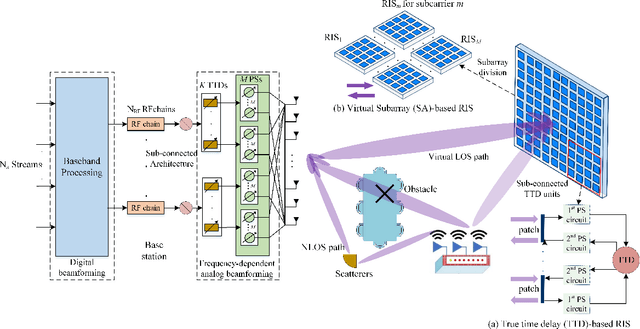
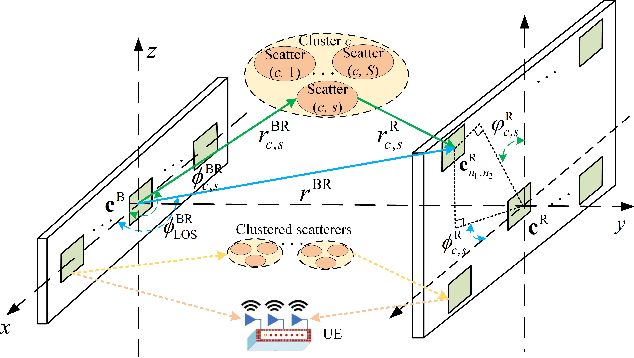
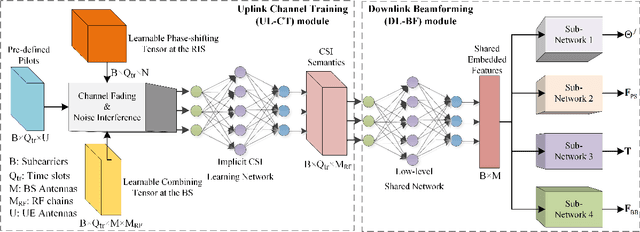
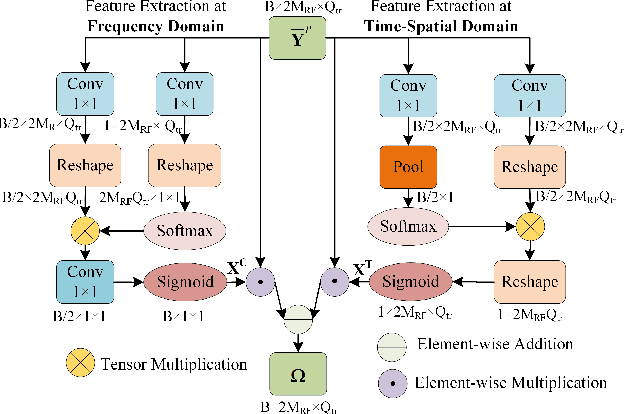
Abstract:A near-field wideband beamforming scheme is investigated for reconfigurable intelligent surface (RIS) assisted multiple-input multiple-output (MIMO) systems, in which a deep learning-based end-to-end (E2E) optimization framework is proposed to maximize the system spectral efficiency. To deal with the near-field double beam split effect, the base station is equipped with frequency-dependent hybrid precoding architecture by introducing sub-connected true time delay (TTD) units, while two specific RIS architectures, namely true time delay-based RIS (TTD-RIS) and virtual subarray-based RIS (SA-RIS), are exploited to realize the frequency-dependent passive beamforming at the RIS. Furthermore, the efficient E2E beamforming models without explicit channel state information are proposed, which jointly exploits the uplink channel training module and the downlink wideband beamforming module. In the proposed network architecture of the E2E models, the classical communication signal processing methods, i.e., polarized filtering and sparsity transform, are leveraged to develop a signal-guided beamforming network. Numerical results show that the proposed E2E models have superior beamforming performance and robustness to conventional beamforming benchmarks. Furthermore, the tradeoff between the beamforming gain and the hardware complexity is investigated for different frequency-dependent RIS architectures, in which the TTD-RIS can achieve better spectral efficiency than the SA-RIS while requiring additional energy consumption and hardware cost.
Exploiting NOMA and RIS in Integrated Sensing and Communication
Oct 06, 2022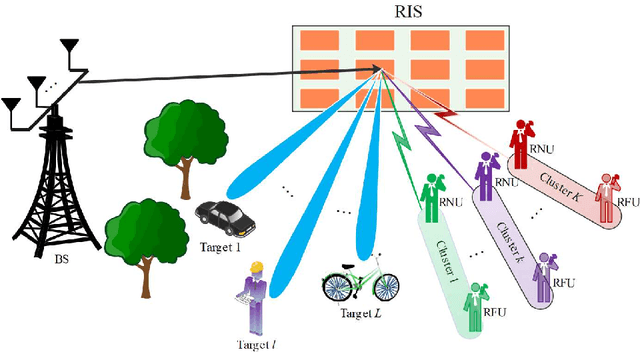
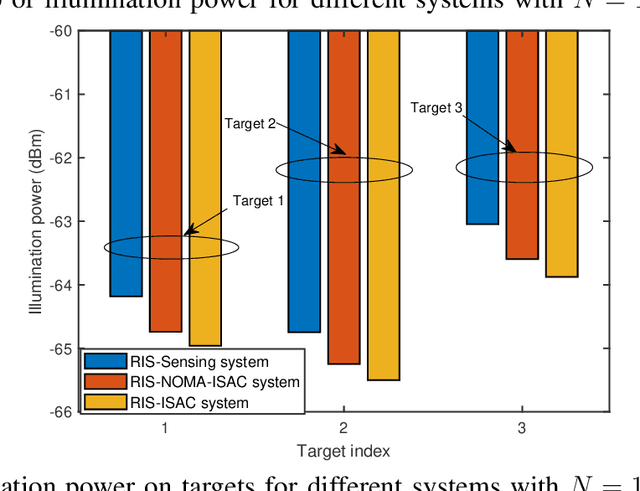
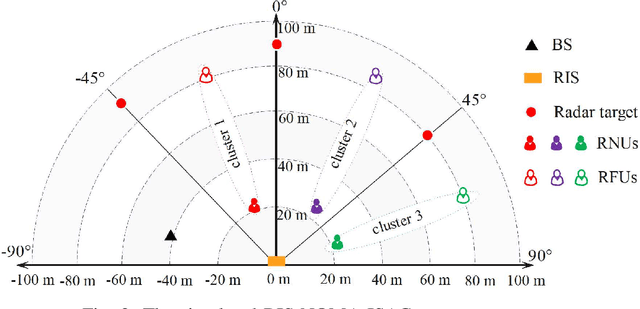
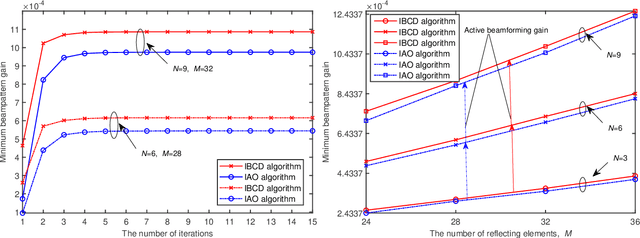
Abstract:A novel integrated sensing and communication (ISAC) system is proposed, where a dual-functional base station is utilized to transmit the superimposed non-orthogonal multiple access (NOMA) communication signal for serving communication users and sensing targets simultaneously. Furthermore, a new reconfigurable intelligent surface (RIS)-aided-sensing structure is also proposed to address the significant path loss or blockage of LoS links for the sensing task. Based on this setup, the beampattern gain at the RIS for the radar target is derived and adopted as a sensing metric. The objective of this paper is to maximize the minimum beampattern gain by jointly optimizing active beamforming, power allocation coefficients and passive beamforming. To tackle the non-convexity of the formulated optimization problem, the beampattern gain and constraints are first transformed into more tractable forms. Then, an iterative block coordinate descent (IBCD) algorithm is proposed by employing successive convex approximation (SCA), Schur complement, semidefinite relaxation (SDR) and sequential rank-one constraint relaxation (SRCR) methods. To reduce the complexity of the proposed IBCD algorithm, a low-complexity iterative alternating optimization (IAO) algorithm is proposed. Particularly, the active beamforming is optimized by solving a semidefinite programming (SDP) problem and the closed-form solutions of the power allocation coefficients are derived. Numerical results show that: i) the proposed RIS-NOMA-ISAC system always outperforms the RIS-ISAC system without NOMA in beampattern gain and illumination power; ii) the low-complexity IAO algorithm achieves a comparable performance to that achieved by the IBCD algorithm. iii) high beampattern gain can be achieved by the proposed joint optimization algorithms in underloaded and overloaded communication scenarios.
Meta-learning for RIS-assisted NOMA Networks
Nov 04, 2021



Abstract:A novel reconfigurable intelligent surfaces (RISs)-based transmission framework is proposed for downlink non-orthogonal multiple access (NOMA) networks. We propose a quality-of-service (QoS)-based clustering scheme to improve the resource efficiency and formulate a sum rate maximization problem by jointly optimizing the phase shift of the RIS and the power allocation at the base station (BS). A model-agnostic meta-learning (MAML)-based learning algorithm is proposed to solve the joint optimization problem with a fast convergence rate and low model complexity. Extensive simulation results demonstrate that the proposed QoS-based NOMA network achieves significantly higher transmission throughput compared to the conventional orthogonal multiple access (OMA) network. It can also be observed that substantial throughput gain can be achieved by integrating RISs in NOMA and OMA networks. Moreover, simulation results of the proposed QoS-based clustering method demonstrate observable throughput gain against the conventional channel condition-based schemes.
Joint User Activity and Data Detection in Grant-Free NOMA using Generative Neural Networks
Jan 07, 2021



Abstract:Grant-free non-orthogonal multiple access (NOMA) is considered as one of the supporting technology for massive connectivity for future networks. In the grant-free NOMA systems with a massive number of users, user activity detection is of great importance. Existing multi-user detection (MUD) techniques rely on complicated update steps which may cause latency in signal detection. In this paper, we propose a generative neural network-based MUD (GenMUD) framework to utilize low-complexity neural networks, which are trained to reconstruct signals in a small fixed number of steps. By exploiting the uncorrelated user behaviours, we design a network architecture to achieve higher recovery accuracy with a low computational cost. Experimental results show significant performance gains in detection accuracy compared to conventional solutions under different channel conditions and user sparsity levels. We also provide a sparsity estimator through extensive experiments. Simulation results of the sparsity estimator showed high estimation accuracy, strong robustness to channel variations and neglectable impact on support detection accuracy.
 Add to Chrome
Add to Chrome Add to Firefox
Add to Firefox Add to Edge
Add to Edge